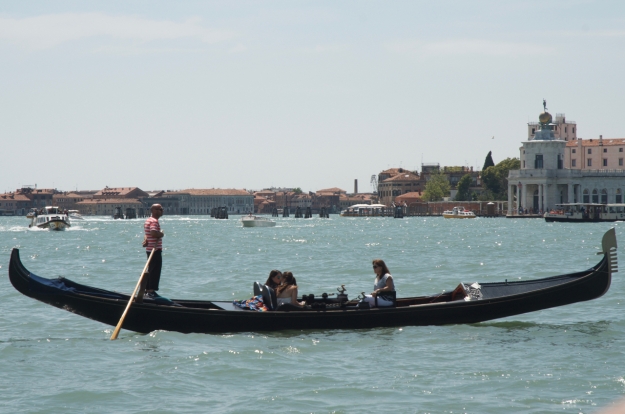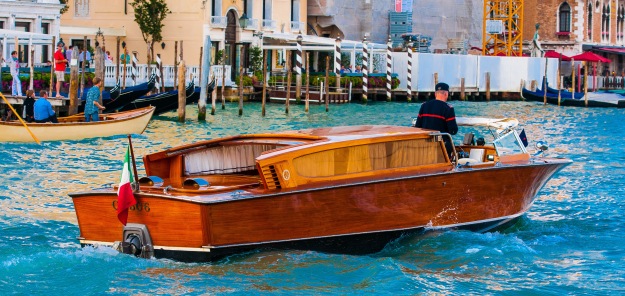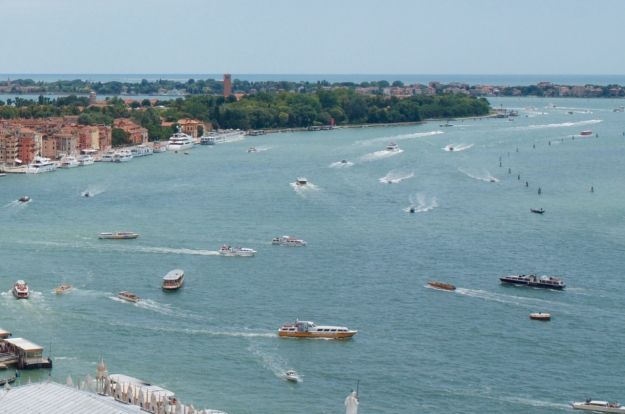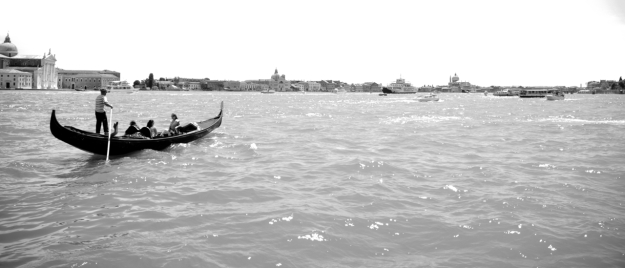I recently discovered that the best way to spend some time in Venice is to buy an all day ticket for the Vaporetto (ferry bus), find a seat at the front, and just take it all in. Over time I found my attention drawn to how the various users of waterways picked their way through the Canal Grande.
Elegant Gondole present tourists with a facsimile of romance and a personal tour of the city’s heart.

Luxurious Taxi d’Acqua provide both the fastest way of getting from A to B and a comfortable way of touring.

(c) Ted McGrath https://flic.kr/p/dQGrm6
Utility barges bring wine and beer (and presumably other goods) into the city, and take the garbage away.
Lumbering Vaporetti move large numbers of tourists and workers en masse through the city.
And so on, all sharing the same small area of water.

Given the vast differences in speed, size and agility of all these craft you might expect a series of strict rules and controls to govern all this, but it appears not. There are no traffic lights or aquatic roundabouts, there is no requirement to stick to one side of the canal or other and no clear right-of-way precedence. What there is is a series of calls and signals that indicate the intentions of the pilots, taxi-drivers and gondoliers to each other. There appear to be a number of common-sense conventions based around the needs and abilities of each craft which are applied, or not, as each situation demands. And the men and women that navigate the canals on a daily basis are highly skilled at what they do.
It is a chaotic system in the physics or maths sense of the word: a complex system whose behaviour is so unpredictable as to appear random. But it is not the randomness of total mayhem, rather the collaborative choreography of a diverse group united in common cause: to service, directly or indirectly, the tourists who are the lifeblood of the city.
Returning to work I was struck by some parallels between the seemingly random and yet ultimately highly effective Venetian waterways and our development process at Singletrack. As a team we have lots of different demands on our time: core product development, support, customer-specific customisations, new customer roll-outs, support of sales efforts and so on. All of these move at different speeds and have different, sometimes competing, characteristics and constraints. Our development process is a mild variation of late-90s XP: a variant because we’re self organising and most of the team wasn’t doing development in the late 90s, and mild because those core practices and principles still work. Its very lightweight, everybody understands it, and its very effective.
I’ve recently begun to worry that this lack of evolution from how I learned to do things nearly two decades ago demonstrates an unwillingness or inability to change. To keep up with the state of the art. I spend time looking at new and different processes and techniques but somehow they fail to engage me and, other than the occasional cherry-picked idea, I go back to what I know.
I realise that it can’t be that Scrum or Kanban or Modern Agile are sham approaches that deliver nothing. It can’t be that NoEstimates and NoProjects have nothing worthwhile to say (even if they do seem to be determined to say it in a particularly negative way). MobProgramming must be good for some people somewhere. But I’ve found them to be limited in value to me.
What my Venetian experience helped me understand is what’s important is that you have a set a of calls, signals and conventions that allow you to collaboratively choreograph your movements, not what that those calls, signals and conventions actually are. The ones that are called XP work for me, maybe the ones called Kanban and MobProgramming work for you. What’s important is that your approach actively works towards the common cause of your organisation not that its the one that gets the most hashtag traffic on Twitter.
When I thought about writing this blog post I did a bit of research on Venice and its waterways. It turns out that what rules and restrictions are imposed had remained unchanged for nearly 200 years until the death of a tourist in 2013 (http://www.telegraph.co.uk/news/worldnews/europe/italy/10268403/Venice-to-control-boat-traffic-on-crowded-canals.html). The response to this tragedy wasn’t to impose a totally new regime of strict controls but simply to update the conventions slightly to reflect Venice in the modern era. Barges have had the hours they can enter the city limited, and illegal docks and piers have been removed, but the fundamentals of the collaborative choreography to suit the common cause remain intact.
So don’t look for the latest or the ‘best’. Look for the calls, signals and conventions that work for you. Find the collaborative choreography that marshals all the disparate people with their disparate needs and disparate talents towards your common cause. Make it work and then keep it working.
